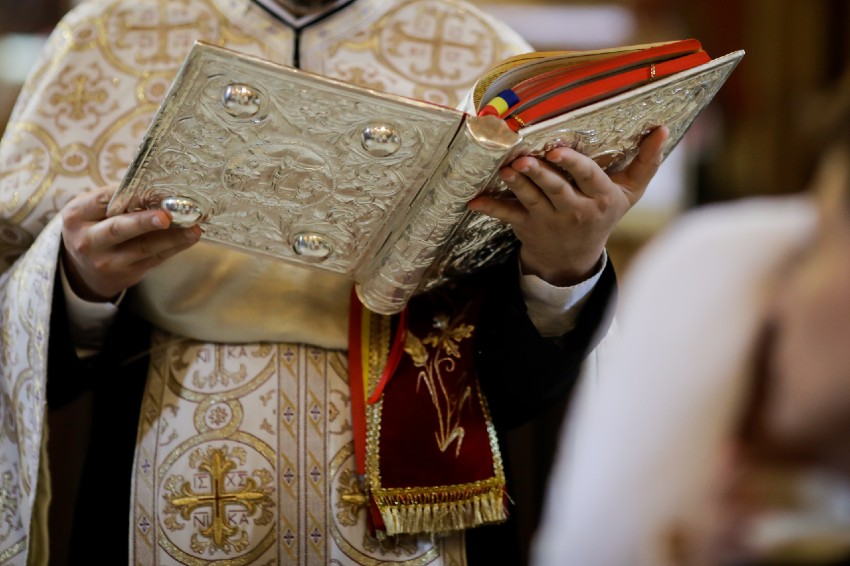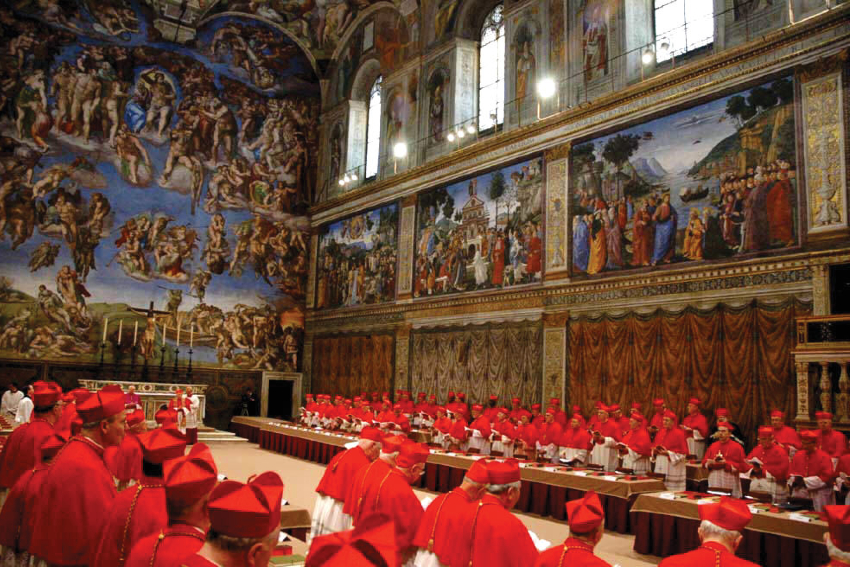June 26, 2015, Friday — On this day…
On this day 15 years ago, in the year 2000, I was in Moscow traveling with Dan Schmidt, Declan Murphy and the late Jack Templeton and his wife, Pina. I was hoping to discover the whereabouts of the lost icon of Our Lady of Kazan, which had come over the centuries to be known in Russia as “the protection of Russia.”
On that morning 15 years ago, on June 26, 2000 — today is the anniversary, and that is why I think of it — there was dramatic news from Rome: the Vatican released the contents of the Third Secret of Fatima.
On the front page of La Repubblica newspaper, the news was reported at the top of the left hand column of the newspaper: “In Rome, the Vatican Reveals the Secret of God…”
Pope John Paul II had ordered Cardinals Ratzinger, Bertone and Sodano to reveal the content of the Third Secret, the secret revealed by “the Lady” to Sister Lucy. It included a bishop clothed in white who was wounded and evidently killed by arrows from many bows…
As I looked at the front page, my eye was drawn to the other side of the page, the right hand column, where it said: “…And in New York, Ventner Reveals the Secret of Man.”
It was story of the completion of the sequencing on the human genetic code, the code which determines who we are, how we live and breathe and how we age and die.
“How appropriate,” I thought. “They (the editors of the paper) have bracketed this day with the two secrets, of man and of God…”
Fifteen years have passed.
September 11 came the following year, and the world changed.
The United States went into Iraq in 2003, against the wishes and outcries of the saintly Pope John Paul II.
He died in 2005, and the world was riveted for days on his funeral, with millions waiting many hours to catch a glimpse of him as he lay in state near the high altar in St. Peter’s Basilica.
Cardinal Ratzinger was elected Pope. In Russia, there was a new openness toward dialogue and collaboration with the Catholic Church, with a German rather than a Polish Pope.
And on July 7, 2007, against the wishes of many in his Curia, Pope Benedict XVI did something that many in the hierarchy never forgave him for: he permitted once again, throughout the Church, the old and solemn rite of the sacrifice of the Mass, rooted in the primitive Church and organically grown in the Church’s life of prayer and praise over neary 20 centuries. And so the old Mass found its place once again in the life of the post-Conciliar Church.
Benedict resigned his office a little more than two years ago. Toward the end, he spoke passionately and dramatically about the danger of a “Promethean humanism,” a new sort of “eating of the apple” which proposed to mankind a new and deeper knowledge of good and evil… at the cost of loss of innocence, and of being barred from that Eden where only the innocent can live. A humanism “without limits.”
Both John Paul and Benedict, especially following the collapse of the Soviet Union in 1989-1991, spoke often and darkly of a grave threat looming over humanity.
For a quarter of a century the Popes of Rome have been warning of a developing “culture of death” in the formerly Christian West.
They said humanity needed to be warned against embracing beliefs and behaviors which seemed attractive but led toward misery and death.
Both Popes urged Western culture to seek instead a “culture of life,” the “good news” of life (Evangelium Vitae) — to seek “that which is above” in order to have life, and have life abundantly.
“That which is above” is the realm, the reign, the kingdom, of the Spirit. Christ called it the Kingdom of God, the Reign of God — it was the content of the message he preached in Galilee in the year 30 A.D.
It pertains to eternal things, not to the things of time.
It pertains to the things of God, even to the secrets of God, and not to the things of man — not even to the secrets of man.
Human beings are extraordinary because they do not coincide with themselves.
A man or a woman is only himself, or herself, when he, or she, transcends himself, or herself.
It is a paradox.
This is another way of saying that men are free beings with consciousness and choice, and therefore beings who live in a realm of morals, of choosing between what is good and what is better, between what is bad and what is worse.
Somewhere on the continuum between moral and immoral, good and evil, between the road to blessedness and the road to misery, each of us lives out his or her existence in this world.
The supreme law of the Church is the salvation of souls. That is, the supreme law of the Church is the protection of souls against falling into misery and death… the guiding of souls into the pathways of righteousness and life.
The method of this saving, the means of this salvation, is sacrificial love.
This brings us full circle, right up to today.
It is June 26, 2015, the 3rd year of the pontificate of Pope Francis, the day on which five justices on the US Supreme Court legalized homosexual marriage.
Four opposed the decision.
The motivation of this contested decision is said to be a profound respect for human love and human freedom.
But two thousand years of Christian teaching tell us that human love is not an infallible measure of morality or goodness.
Only divine love is such an infallible measure. Human love is only a pale reflection of divine love.
Human love is inevitably imperfect. It can be clinging, it can be narcissistic, it can be obsessive, it can be abusive. Human love must continually be purified.
And its purification must come through sacrifice.
Human beings, creatures with spirits (souls) and bodies, beings both spiritual and carnal, live their emotional lives stretched out on a continuum between “me” and “we,” between selfishness and selflessness, between eros and agape — between erotic love, passionate love, and agape love, brotherly love, selfless love.
The Church has blessed the carnal and generative love of human beings through and in the sacrament of marriage, and has understood marriage to be a “great mystery,” a spiritual union of two beings which echoes or reflects the spiritual union between Christ and His Church — the Bridegroom and the Bride.
And also in her wisdom, the Church has spoken with reverence of that path of self-denial known as chaste love. And so the Church praises chastity — praises a life lived fully in that agape love which one feels for one’s brother, or sister, or son, or daughter, or friend. That love which desires goodness and blessing in the life of the one loved.
There is no sexuality in such love, nothing carnal. It is spiritual.
And the forgetfulness of this spiritual path, of this sacrificial way of living and being which brings forth the fruits of blessedness into the world — which brings forth peace, and family unity, and social harmony, and festive celebration — is the most tragic malaise of our age.
We have lost our way. We think that the way we are choosing will lead us toward greater freedom and satisfaction, but it is a path that attempts to consecrate the carnal, to deny that spiritual realm — the only reality of true blessedness.
We continue to seek out the “secret of man,” to unveil the “genetic code,” to discover what causes us to age or fall ill, and in the process we increasingly neglect the “secret of God.”
That secret is the hidden face of God. It is the face of the “Thrice-Holy” — the face which to gaze upon is eternal blessedness (beatific vision): eternal life.
The vision of that face is the life of man — the source of the “culture of life.”
The glory of that face is the life of those men and women who have glimpsed the face, and who, through sacrament and sacrifice, having been illuminated and transformed by what they have glimpsed, live in the world, but not of it…
Cardinal: “What Sister Lucia told me: Final Confrontation between the Lord and Satan will be over Family and Marriage.”
A Cardinal tells: Sister Lucia wrote me…
On Feburary 16, 2008, Cardinal Carlo Caffara (Archbishop of Bologna), after a Mass celebrated at the tomb of St. Pio of Pietrelcina, granted an interview toTele Radio Padre Pio, which was subsequently reported in the monthly magazine Voce di Padre Pio in March, 2008 . Here are some significant excerpts.
Your Eminence, recently in Corriere della Sera you said that you had always had a great devotion to Padre Pio. Please tell us why.
Cardinal Carlo Caffara: I have had great devotion to him since the beginning of my priesthood as a result of a rather unique experience. I had been a priest for some months and a brother-priest came to see me. He was quite a bit older than me and was going through a serious crisis of faith. It is difficult to describe what a crisis of faith is for a priest: a terrible thing! I told him “Brother, I’m too little, and sense that I can’t carry such a burden. Go to Padre Pio.” So he went, and while he was talking to Padre he had a great mystical experience, touched profoundly by the mercy of God. Now he is one of the best priests I know. There you have it, it all began like that.
Did you ever meet Padre Pio personally?
Caffara: No, I didn’t. I never had the courage to go to him, thinking that I would be wasting his time! […] I retain that Padre Pio belongs to the series of great mystics who have this characteristic: the most profound sharing in the Cross of Christ, as they carry upon themselves the great tragedy of mankind today – atheism. Padre Pio, St. Gemma Galgani, St. Teresa Benedicta of the Cross , Mother Theresa, the Curé d’Ars all had the experience of sitting round the table with sinners, living their experiences, of carrying, in a different way, the weight of the Agony in Gethsemane; they testified to the love of Christ Who takes upon Himself, the pain of the man who has left his Father’s house and doesn’t want to go back, even if he knows in his heart that he is better off in his Father’s house rather than tending to pigs. Man today continues to imagine that he can live as if God didn’t exist; and we see the devastation this has caused.
There is a prophecy by Sister Lucia dos Santos, of Fatima, which concerns “the final battle between the Lord and the kingdom of Satan”. The battlefield is the family. Life and the family. We know that you were given charge by John Paul II to plan and establish the Pontifical Institute for the Studies on Marriage and the Family…
Caffara: Yes, I was. At the start of this work entrusted to me by the Servant of God John Paul II, I wrote to Sister Lucia of Fatima through her Bishop as I couldn’t do so directly.
Unexplainably however, since I didn’t expect an answer, seeing that I had only asked for prayers, I received a very long letter with her signature – now in the Institute’s archives.
In it we find written: the final battle between the Lord and the reign of Satan will be about marriage and the family. Don’t be afraid, she added, because anyone who works for the sanctity of marriage and the family will always be fought and opposed in every way, because this is the decisive issue.
And then she concluded: however, Our Lady has already crushed its head.
Talking also to John Paul II, one felt too that this was the crux, as it touches the very pillar of creation, the truth of the relationship between man and woman among the generations.
If the founding pillar is touched the entire building collapses and we see this now, because we are at this point and we know it.
And I’m moved when I read the best biographies of Padre Pio , on how this man was so attentive to the sanctity of marriage and the sanctity of the spouses, even with justifiable rigor on occasion.
(Source: Rorate Caeli. Translation: Contributor Francesca Romana. Source: Voce di Padre Pio.)
Note: For those who would like to travel with us on pilgrimage:
(1) In mid-July 2015, we will travel with a small group of Inside the Vatican readers on our annual “Urbi et Orbi” pilgrimage to Russia, Turkey and the Vatican;
(2) On December 8, 2015, and again on November 20, 2016, we will be gathering in Rome to be present when Pope Francis opens the Holy Door to begin his Special Jubilee of Mercy, and when he closes the door to end the Jubilee Year. If you would like to join us on one or more of these pilgrimages, email now for more information…
We also often travel to Norcia, in central Italy, where there is a flourishing Benedictine monastery we visit.
Also, if you have not yet subscribed to the magazine, please consider doing so.
Every single subscriber is important to us. Please take a subscription — it is a very important help to us. To subscribe, click here:
Donations are also appreciated. To donate, click here.
What is the glory of God?
“The glory of God is man alive; but the life of man is the vision of God.” —St. Irenaeus of Lyons, in the territory of France, in his great work Against All Heresies, written c. 180 A.D.







Facebook Comments